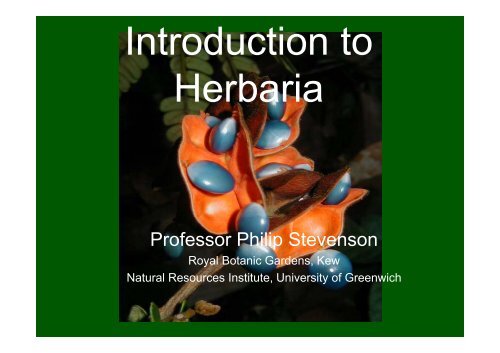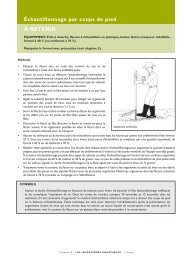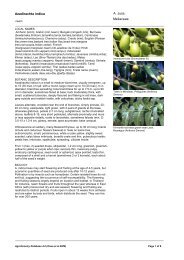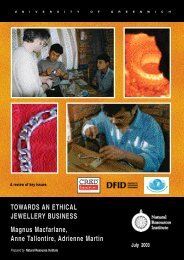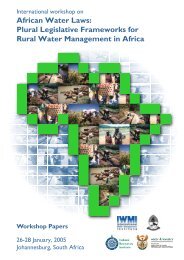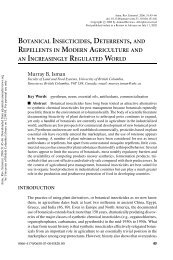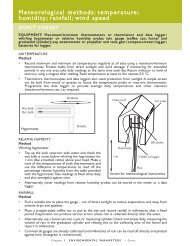Herbarium introduction - Natural Resources Institute
Herbarium introduction - Natural Resources Institute
Herbarium introduction - Natural Resources Institute
Create successful ePaper yourself
Turn your PDF publications into a flip-book with our unique Google optimized e-Paper software.
Introduction to<br />
Herbaria<br />
Professor Philip Stevenson<br />
RRoyal l BBotanic t i GGardens, d KKew<br />
<strong>Natural</strong> <strong>Resources</strong> <strong>Institute</strong>, University of Greenwich
The <strong>Herbarium</strong><br />
• A collection of dried plants<br />
• A store of reference material<br />
• A means of identification<br />
• An arbiter of correct names<br />
• A comprehensive data-bank<br />
“The essential working tool for systematics”
Role of the <strong>Herbarium</strong><br />
• Identification<br />
• Taxonomic research<br />
• Data repatriation (including databasing)<br />
• IUCN Conservation ratings<br />
• Voucher specimens<br />
– Ecological<br />
– DNA sequencing<br />
– Phytochemical<br />
y
Fieldwork and the <strong>Herbarium</strong><br />
• Fi Field ld Id Identifications tifi ti diffi difficult lt<br />
– Tropical habitats very diverse<br />
– Family or genus level<br />
– Floras often not available (tropics ( p especially) p y)<br />
– Floras bulky<br />
• EEcological l i l fi fieldwork: ld k<br />
– Plots, often sterile vouchers, shorter-term<br />
• Taxonomic fieldwork:<br />
– General collecting, collecting fertile material material, long long-term<br />
term
Herbaria around the world<br />
• General or international herbaria<br />
• National and regional<br />
– E.g., Forest Research <strong>Institute</strong> Malaysia (FRIM)<br />
FForest t <strong>Herbarium</strong>, H b i SSarawak k (SAR)<br />
Forest Research Centre, Sabah (SAN)<br />
• University herbaria<br />
• Local botanists = local contacts<br />
• Index Herbariorum
HHerbaria b i ffrom around d th the world<br />
ld
Field to specimen
Specimen<br />
Determinavit slip<br />
Loose parts<br />
Label<br />
Barcode<br />
<strong>Herbarium</strong> stamp
The Kew <strong>Herbarium</strong><br />
• Approx Approx. 5 million specimens<br />
• Comprehensive collections from all regions<br />
Wing C - 1857<br />
Wing A - 1903
The Kew herbarium contd contd.<br />
• Specimen arrangement<br />
– Phylogenetic y g according g to Bentham and<br />
Hooker (1880)<br />
– Re-arrangement Re arrangement with the new wing<br />
• Mabberley’s Plant Book (new edition)<br />
• St Staff ff ‘arrangement’<br />
‘ t’<br />
– Regional teams<br />
– Systematic teams
Regional Teams<br />
• South-East Asia and Pacific<br />
• Drylands Africa<br />
• Africa Wet tropics<br />
• South America<br />
• Temperate<br />
• Name all material except systematic families<br />
• Sorts Sorts, identification identification, field guides guides, and research
Systematic Teams<br />
• MMalpighiales l i hi l (E (Euphorbs) h b )<br />
•Myrtaceae y (Eucaplypts ( pyp etc.) )<br />
• Labiatae/Lamiaceae (Mints)<br />
• Rubiaceae (Coffee)<br />
• Leguminosae (Peas and beans)<br />
• Monocots<br />
• Monographic and phylogenetic research
Data repatriation of<br />
4000 specimens<br />
ffrom Mexico M i and d<br />
Central America<br />
Digitisation progress<br />
Nearly 50,000<br />
legume specimens<br />
on-line<br />
32 legume<br />
“species pages”
Tephrosia p vogelii g<br />
Plants reportedly used (%) in<br />
Malawi for pest control (n=167)<br />
Some farmers report no activity from Tephrosia
Callosobruchus maculatus
eggs<br />
ber of e<br />
n numb<br />
Mean<br />
Oviposition by fecund bruchid beetles<br />
on cowpea seeds treated with<br />
powdered plant @1% w/v after 48 h.
Rotenoids from Tephrosia vogelii leaves<br />
O<br />
Deguelin R=H<br />
Tephrosin R = OH<br />
O<br />
O<br />
O<br />
H<br />
R<br />
O<br />
OMe<br />
OMe<br />
O R<br />
OMe O<br />
O<br />
O<br />
H<br />
Rotenone R=H<br />
12α-hydroxyrotenone R = OH<br />
O<br />
O<br />
O<br />
O<br />
OH<br />
OMe<br />
OMe OH O<br />
Sarcolobine Toxicarol<br />
O<br />
O<br />
OMe<br />
O<br />
OMe<br />
OMe<br />
OMe
Is T. . candida effective?<br />
Tephrosia<br />
vogelii.<br />
Controls bruchids<br />
Tephrosia<br />
candida<br />
Promoted for soil<br />
improvement (N2 fixing<br />
& green mulch)<br />
and (assumed) pest<br />
control properties.<br />
(growing at an International Agroforestry Centre)
1<br />
Oh – its actually TT.<br />
. vogelii<br />
Tephrosia<br />
vogelii.<br />
Controls bruchids<br />
Tephrosia<br />
candida<br />
Promoted for soil<br />
improvement (N2 fixing<br />
& green mulch)<br />
2<br />
and (assumed) pest<br />
control properties.<br />
Plastid Ltrn region, ITS nuclear DNA sequences &<br />
morphology indicate both to be T. vogelii
Numbber<br />
of inseects<br />
(%)<br />
100<br />
90<br />
80<br />
70<br />
60<br />
40<br />
30<br />
Effect on C. maculatus of cowpea<br />
ttreated t d with ith acetone t extracts t t of f<br />
T. vogelii chemotypes after 48 h.<br />
50 Dead<br />
20<br />
10<br />
0<br />
2% 0.20% 0.02% 2% 0.20% 0.02% AcO<br />
Chemotype 1 Chemotype 2 Control<br />
Sick insects are alive but paralysed<br />
Sick<br />
Healthy
1<br />
2<br />
LC LC-MS MS chromatograms of<br />
T. vogelii chemotypes 1 & 2<br />
Tvogelii herb specimen 34mg/ml<br />
3 x Fig 150 mm 1a Phenomenex HPLC Luna C18(2), chromatogram 95:0:5(0 min) 0:95:5(20 min) of 0:95:5(25 T. vogelii min), water : MeOH chemotype : ACN +1% formic acid 1<br />
PhilSAPP<br />
22-Oct-2009<br />
PhilSAPP<br />
Tvogelii herb specimen 1 3: Diode Array<br />
19.40<br />
Range: 4.337e+2<br />
AU<br />
3.5e+2<br />
3 3.0e+2 0e+2<br />
2.5e+2<br />
2.0e+2<br />
1.5e+2<br />
1.0e+2<br />
5.0e+1<br />
12.03<br />
12.62<br />
15.12<br />
deguelin<br />
tephrosin<br />
tephrosi<br />
sarcolobine 18.75<br />
sarcolobin n<br />
e<br />
deguelin<br />
rotenone<br />
rotenone<br />
11.50 12.00 12.50 13.00 13.50 14.00 14.50 15.00 15.50 16.00 16.50 17.00 17.50 18.00 18.50 19.00 19.50 20.00 20.50 21.00 21.50 22.00<br />
Tcandida BI19309 3: Diode Array<br />
20.68<br />
Range: g 6.261e+1<br />
AU<br />
Fig 5.0e+1 1b HPLC chromatogram of T. vogelii<br />
chemotype 2 Obovatin<br />
Obovatin<br />
5-methylether<br />
O<br />
O<br />
5-methylether<br />
4.0e+1<br />
3.0e+1 12 12.00 00 12.58<br />
2.0e+1<br />
1.0e+1<br />
0.0<br />
13.40<br />
OMe<br />
O<br />
15.12<br />
20.35<br />
toxicarol<br />
Z-tephrostachin Z-<br />
4 4 & & 5<br />
tephrostachin<br />
1 & 2 3<br />
19.93 5<br />
6<br />
Time<br />
11.50 12.00 12.50 13.00 13.50 14.00 14.50 15.00 15.50 16.00 16.50 17.00 17.50 18.00 18.50 19.00 19.50 20.00 20.50 21.00 21.50 22.00<br />
Compound IDs based on 700MHz NMR and Orbitrap HR-EI MS<br />
20.37
Flavanones and flavones from<br />
T. vogelii chemotype 2 (inactive)<br />
O O<br />
OMe<br />
O<br />
OMe<br />
O<br />
2<br />
O<br />
O<br />
H<br />
R<br />
O<br />
HO<br />
OMe<br />
Obovatin 5-methylether 3<br />
OMe<br />
Deguelin R=H<br />
Tephrosin R=OH R = OH<br />
Z-tephrostachin<br />
O<br />
OMe<br />
O<br />
O<br />
OH<br />
O<br />
OMe<br />
*two two of 6 new<br />
flavonoid aglycones<br />
Yukovanol 55-methylether methylether * TTephrovogelone* h l *<br />
Stevenson et al., Phytochemistry (submitted)<br />
O<br />
O<br />
O O<br />
O
Mildbraediodendron excelsum<br />
<strong>Herbarium</strong> sheet:<br />
Specimen collected by<br />
Johannes Mildbraed in 1928<br />
Living specimen:<br />
Grown from seed collected<br />
iin 1996 1996, Mt Mt. KKupe, CCameroon
AU<br />
AU<br />
LC-UV Analysis of Mildbraediodendron excelsum<br />
Living specimen<br />
Mildbraed 10643<br />
2 4 6 8 10 12 14 t (min)<br />
ANALYTES: 50% aq. MeOH<br />
LC chromatogram (total scan PDA)<br />
extracts of leaflet material
MILDBRAEDIN: a flavonol tetraglycoside from<br />
Mildbraediodendron excelsum<br />
HO<br />
OH<br />
O<br />
O OH 7<br />
α-RhaI<br />
O CH<br />
1<br />
3<br />
3 O<br />
OH<br />
3 O<br />
OH O O<br />
1<br />
1 2<br />
O<br />
O<br />
OH<br />
β-Gal<br />
OHOH CH3<br />
CH HO<br />
3 6 HO<br />
CH HO α-RhaII<br />
2<br />
α-RhaIII O O<br />
HO 1<br />
HO<br />
Main phenolic component of:<br />
(1) <strong>Herbarium</strong> leaf fragment (1928)<br />
(2) Li Living i specimen i<br />
Veitch et al. (2005) Tetrahedron Lett. 46, 8595
Abundance<br />
Relative<br />
100<br />
50<br />
Flavonol pentaglycosides of Cordyla haraka<br />
LC m/z = 1033 UV<br />
m/z = 1047<br />
265<br />
348<br />
200 300 400<br />
λ (nm)<br />
0<br />
0 5 10 15 20 25 30 35<br />
t (min)<br />
Relative Abunndance<br />
100<br />
Ion current chromatogram 40<br />
Cordyla haraka<br />
D. Du Puy<br />
90<br />
80<br />
70<br />
60<br />
50<br />
30<br />
20<br />
10<br />
0<br />
MS<br />
-146 146<br />
287<br />
-162 162<br />
433<br />
-146 146<br />
595<br />
-146 146<br />
741<br />
-146 146<br />
887<br />
1033<br />
m/z<br />
200 400 600 800 1000 m/z<br />
Electrospray mass spectrum
CH 3<br />
HO<br />
HO<br />
Distribution of flavonol pentaglycosides in Cordyla s.l.<br />
HO<br />
O<br />
α-RhaIV<br />
1<br />
O<br />
7<br />
α-RhaIII<br />
OH<br />
O<br />
O<br />
CH 3<br />
HO<br />
HO<br />
Amburana<br />
Mildbraediodendron<br />
Cordyla<br />
M. excelsum<br />
Cordyla CC. africana f i<br />
C. densiflora<br />
Aldina<br />
C. haraka<br />
C. madagascariensis<br />
C. pinnata<br />
C. richardii<br />
OH<br />
C. somalensis<br />
3<br />
β-Gal<br />
HO<br />
O<br />
O<br />
O<br />
O<br />
OH<br />
1<br />
1 2<br />
3<br />
O<br />
OHOH<br />
6<br />
O<br />
CH 2<br />
R = OH, Cordylasin B<br />
R = H, Cordylasin A<br />
1<br />
CH 3<br />
α-RhaI<br />
OH<br />
O<br />
1<br />
O α-RhaII α RhaII<br />
HO<br />
HO<br />
OH<br />
CH3<br />
Dupuya haraka<br />
Dupuya madagascariensis<br />
CONCLUSIONS:<br />
C. haraka allied with<br />
C. pinnata & C. richardii<br />
NNo support t ffor transfer t f off<br />
C. haraka to Dupuya<br />
Veitch, Kite & Lewis (2008) Phytochemistry 69, 2329


